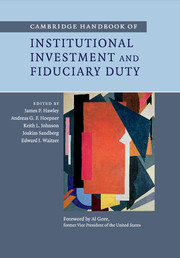Book contents
- Frontmatter
- Contents
- List of figures
- List of tables
- List of contributors
- Foreword
- 1 Introduction
- Part I Fiduciary duty: a global outlook
- Part II Fiduciary duty and the landscape of institutional investment
- Part III Challenging conventional wisdom on fiduciary duty
- Part IV Towards a broader interpretation of fiduciary duty
- Part V Beneficiaries’ roles and viewpoints
- Part VI Fiduciary duty and governance
- 30 Investors and global governance frameworks: broadening the multi-stakeholder paradigm
- 31 Promoting corporate sustainability through integrated reporting: the role of investment fiduciaries and the responsibilities of the corporate board
- 32 Reporting and standards: tools for stewardship
- 33 US corporate governance, fiduciary success and stable economic growth
- 34 Fulfilling fiduciary duties in an imperfect world – governance recommendations from the Stanford Institutional Investor Forum
- 35 Addressing the participation gap in institutional investment: an assessment framework and preliminary results
- 36 The costs of fiduciary failure – and an agenda for remedy
- Index
- References
34 - Fulfilling fiduciary duties in an imperfect world – governance recommendations from the Stanford Institutional Investor Forum
Published online by Cambridge University Press: 05 April 2014
- Frontmatter
- Contents
- List of figures
- List of tables
- List of contributors
- Foreword
- 1 Introduction
- Part I Fiduciary duty: a global outlook
- Part II Fiduciary duty and the landscape of institutional investment
- Part III Challenging conventional wisdom on fiduciary duty
- Part IV Towards a broader interpretation of fiduciary duty
- Part V Beneficiaries’ roles and viewpoints
- Part VI Fiduciary duty and governance
- 30 Investors and global governance frameworks: broadening the multi-stakeholder paradigm
- 31 Promoting corporate sustainability through integrated reporting: the role of investment fiduciaries and the responsibilities of the corporate board
- 32 Reporting and standards: tools for stewardship
- 33 US corporate governance, fiduciary success and stable economic growth
- 34 Fulfilling fiduciary duties in an imperfect world – governance recommendations from the Stanford Institutional Investor Forum
- 35 Addressing the participation gap in institutional investment: an assessment framework and preliminary results
- 36 The costs of fiduciary failure – and an agenda for remedy
- Index
- References
Summary
Introduction
From the perspective of a full-time practitioner in US pension and fiduciary law, debate and discussion over the future direction of the law of fiduciary duty and/or the governance structures of pension funds is extremely important. However, in the here and now, under existing fiduciary duty and plan governance constructs, US public pension board members and their staffs are making decisions concerning complex issues that affect the retirement security of more than 28 million Americans covered by public sector defined benefit plans (US Census Bureau and Becker-Medina 2012). They are often doing so in a highly charged environment. While many US systems are well-funded, in a significant number of highly publicized cases systems face the unprecedented twin challenges of coping with unfunded liabilities resulting from market conditions not seen since the Great Depression coupled with plan sponsors that are under tremendous financial pressure to maintain essential public services in the face of declining revenues and are not in the position to provide the increased employer contributions necessary to restore fiscal stability to the funds. Making things even more difficult is the drumbeat of those who would benefit either politically or financially from the demise of defined benefit pension plans for US public employees.
The overwhelming majority of the approximately $2.7 trillion held by 3,400 US state and local public pension plans (ibid.) is managed by lay boards consisting of from seven to thirteen individuals that come to their position by one of three ways: they are either appointed by the plan sponsor, elected from the plan membership or are “ex officio” members that become a member of the pension board because they have been elected or appointed to another public office, such as state treasurer (National Association of State Retirement Administrators 2013). In meetings that are generally open to the public, save for matters involving litigation, personnel or (sometimes) investment matters, these boards consider, discuss and act upon the plan administration, investment and actuarial matters that bear directly upon the system’s ultimate objective of ensuring that sufficient plan assets are available to provide for the prompt and accurate payment of benefits to their existing and future retirees.
- Type
- Chapter
- Information
- Publisher: Cambridge University PressPrint publication year: 2014



